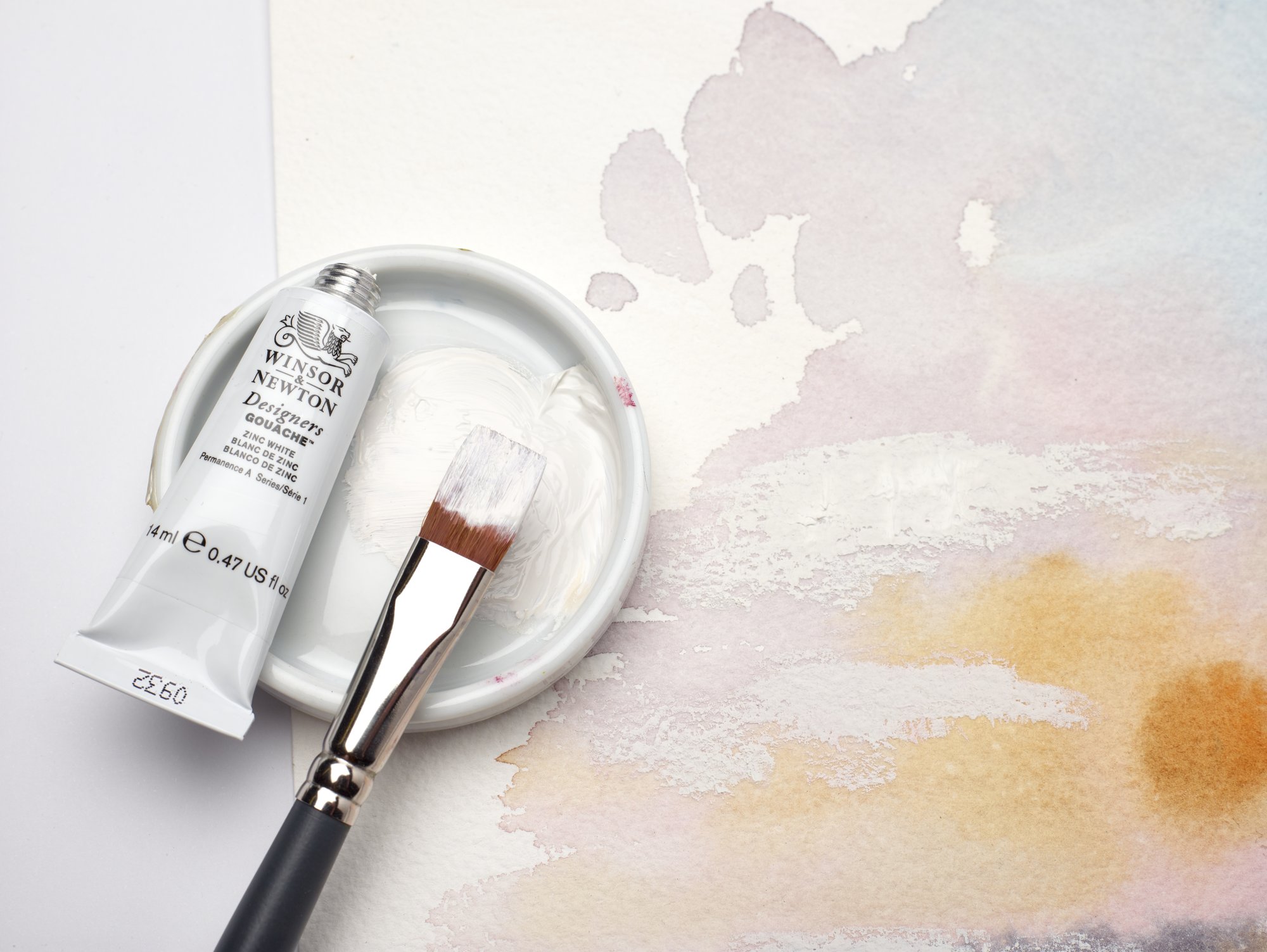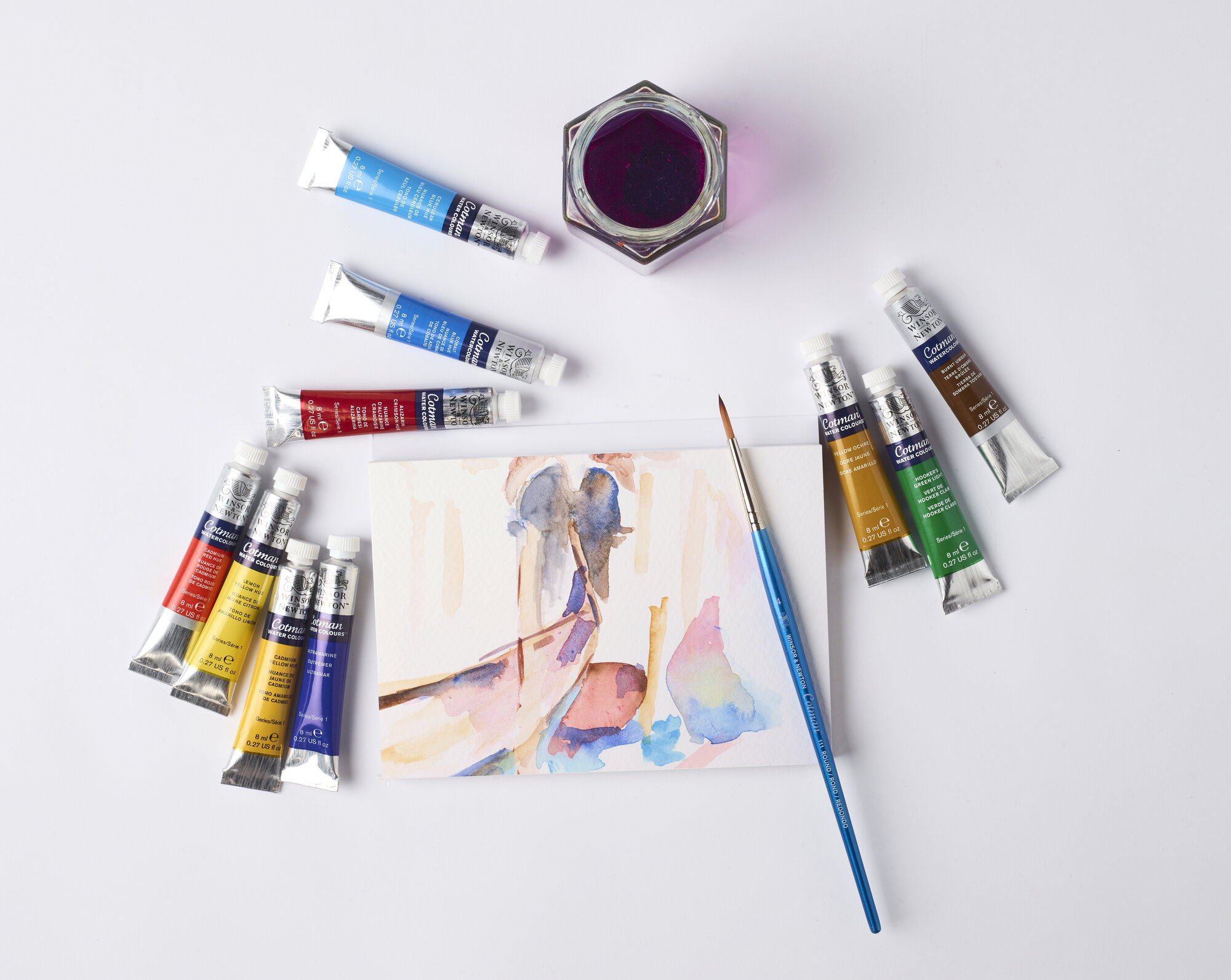Gouache vs watercolour are two distinct yet closely related painting mediums that have captivated artists for centuries. Gouache, an opaque water-based paint, is known for its thick consistency and ability to provide full coverage with a matte finish. On the other hand, watercolour is a transparent, water-soluble paint celebrated for its delicate and luminous appearance. Understanding the differences between gouache and watercolour is crucial for artists seeking to choose the best medium for their particular style, subject matter, and desired effects. Moreover, being familiar with the unique characteristics of each medium can help artists develop new techniques and broaden their creative horizons.
Characteristics of Gouache
Gouache is a versatile and vibrant medium known for its opacity, coverage, and rich colours. Its composition allows for easy layering, a range of styles, and convenient corrections. While compatible with multiple surfaces, heavyweight watercolour paper remains the top choice due to its absorbency and paint-holding abilities.
Composition and ingredients
Gouache is composed of pigments, water, and a binding agent, which is typically gum arabic or dextrin. The paint may also include additional ingredients, such as chalk, to enhance its opacity and produce a distinctive matte finish.
Opacity and coverage
One of the primary differences between gouache and watercolour is the level of opacity. Gouache is highly opaque, providing excellent coverage and allowing artists to easily layer colours without the underlying layers showing through.
Colour vibrancy and mixing capabilities
Gouache boasts vibrant colours and exceptional mixing capabilities. Its opaque nature enables the creation of bold, intense hues that can be easily mixed to produce a wide array of shades and tones.
Drying time and reactivating properties
Compared to oil paints, gouache dries relatively quickly but takes longer to dry than watercolours. Once dry, gouache can be reactivated with water, making it simple to correct mistakes or adjust a painting.
Surface compatibility
Gouache works well on a variety of surfaces, including paper, canvas, and wood. However, it is most commonly used on heavyweight watercolour paper due to its absorbent nature and ability to hold the paint effectively.
Characteristics of Watercolour
Watercolour is a delicate, luminous medium prized for its transparency and layering effects. Its composition allows for easy adjustments in colour intensity and corrections. For optimal results, artists use heavyweight watercolour paper to prevent warping or buckling.
Composition and ingredients
Watercolour paint consists of finely ground pigments combined with a water-soluble binder, typically gum arabic. Some watercolours may also include additives such as honey or glycerine to enhance the paint's flow and workability.
Transparency and layering
Watercolour is known for its transparency, allowing for beautiful layering effects. By applying thin layers of paint, artists can create a sense of depth and luminosity in their work.
Colour intensity and transparency
The intensity and transparency of watercolour paint can be controlled by adjusting the amount of water used during application. More water results in a lighter, more transparent wash, while less water produces a more vibrant, intense colour.
Drying time and reactivating properties
Watercolour paint dries rapidly, often within minutes, depending on the thickness of the application and the surrounding humidity. Like gouache, watercolour can be reactivated with water even after it has dried, allowing for adjustments and corrections.
Surface compatibility
Watercolour is best suited for use on high-quality, heavyweight watercolour paper. This type of paper is specifically designed to absorb the paint and prevent it from warping or buckling as it dries.
Application Techniques
Techniques specific to gouache
Flat washes: Gouache is excellent for creating flat, even washes of colour. This technique involves applying a consistent layer of paint across the surface, making it ideal for backgrounds or large areas of colour.
Dry brushing: By using a brush with minimal paint and little water, artists can create textured effects with gouache. This technique is effective for adding depth and dimension to a painting.
Opaque layering: Due to its opacity, gouache allows for layering without the underlying colours showing through. Artists can build up layers to create complex compositions and add details without disturbing previous applications.
Impasto: Using thick layers of gouache can create an impasto effect, achieving a textured, three-dimensional appearance.
Techniques specific to watercolour
Wet-on-wet: This technique involves applying wet paint onto a wet surface, allowing colours to blend and flow into each other. Wet-on-wet creates soft, diffused effects and is ideal for capturing atmospheric qualities.
Wet-on-dry: In contrast, wet-on-dry involves applying wet paint onto a dry surface, resulting in sharp, defined edges. This technique is perfect for creating detailed elements and crisp lines.
Glazing: Glazing consists of applying thin, transparent layers of paint on top of one another. This technique builds up depth and luminosity while maintaining the transparency of the watercolour medium.
Lifting: Lifting is the process of removing wet or dried paint by gently blotting or rubbing with a damp brush or tissue. This technique is useful for creating highlights, correcting mistakes, or adding texture.
Advantages and Disadvantages of Gouache
Advantages
- Opacity: Gouache's high opacity allows for excellent coverage and layering without underlying colours showing through.
- Versatility: Suitable for various artistic styles and techniques, gouache caters to a wide range of artists.
- Easy adjustments: Gouache can be reactivated with water, making corrections and adjustments convenient.
- Rich colours: Gouache offers vibrant and bold colours that can be easily mixed to create a diverse palette.
Disadvantages
- Drying shift: Gouache may experience colour and value shifts as it dries, making it difficult to predict the final appearance.
- Fragility: Gouache can be prone to cracking or flaking if applied too thickly or not properly stored.
- Reactivation: The reactivation property of gouache can be a disadvantage if unintended blending occurs when working on multiple layers.
Advantages and Disadvantages of Watercolour
Advantages
- Transparency: watercolour's transparency allows for beautiful layering effects and luminosity in artwork.
- Quick drying: Watercolour dries rapidly, enabling artists to work efficiently.
- Portability: Watercolour materials are lightweight and portable, making them ideal for plein air painting and travel.
- Easy cleanup: Watercolour paint is water-soluble, making cleanup simple and hassle-free.
Disadvantages
- Limited opacity: watercolour's transparency can make it challenging to achieve full coverage or completely hide previous layers.
- Difficult corrections: While watercolour can be reactivated, correcting mistakes can be more challenging due to its transparent nature.
- Paper warping: Watercolour requires high-quality, heavyweight paper to prevent warping or buckling, which can be expensive.
- Sensitivity to water: Watercolour paintings are susceptible to damage from water or humidity, requiring careful handling and storage.
Choosing Between Gouache and Watercolour
Considerations for subject matter and style
- Gouache is well-suited for bold, vibrant artwork with strong colours and solid shapes, making it ideal for graphic design, illustration, and poster art.
- Watercolour's transparency lends itself to delicate, luminous pieces that showcase depth, light, and atmosphere, making it a popular choice for landscape and botanical artists.
Considerations for desired effects and techniques
- If opacity, layering, and bold colour applications are priorities, gouache may be the better choice.
- For artists seeking transparency, luminosity, and the ability to create subtle washes and glazes, watercolour is likely the preferred medium.
Budget and accessibility
- Both gouache and watercolour paints are available across various price points, but high-quality watercolour paper can be more expensive than other surfaces.
- Watercolour materials are generally more portable and accessible, making them a popular choice for artists on the go or those working in plein air.
Experimentation and personal preference
- As both mediums share similarities, experimenting with each can help artists determine which best suits their individual style and preferences.
- Some artists may choose to combine both gouache and watercolour in a single piece, capitalising on the unique characteristics of each medium. Ultimately, personal preference and artistic goals will guide the choice between gouache and watercolour.
In conclusion, while gouache and watercolour share similarities as water-based mediums, they offer unique attributes that cater to different artistic styles and techniques. The key differences between the two lie in their opacity, layering capabilities, and application methods. Artists are encouraged to explore and experiment with both mediums to uncover their individual strengths and potential applications. By understanding the versatility and beauty of gouache and watercolour, artists can make informed decisions about which medium best aligns with their creative vision and goals, ultimately leading to more captivating and engaging artwork.
Additional Reading
What is Gouache Paint and How to Use it?
Best Watercolour Paints in 2023
FAQ on Gouache vs Watercolour
Q: What is the difference between gouache and watercolour?
A: Gouache and watercolour are both water-based painting mediums, but they have some distinct characteristics. Gouache is opaque and dries with a matte finish, while watercolour is transparent and dries with a subtle translucency. Gouache can be layered more easily without showing the layers underneath, while watercolour allows for more transparent washes and delicate layering.
Q: Can gouache be used like watercolour?
A: Yes, gouache can be used like watercolour. It can be thinned with water and applied in transparent washes, creating similar effects to watercolour. However, gouache's opaque nature allows for more flexibility in layering and correcting mistakes, making it a versatile medium for both transparent and opaque techniques.
Q: Which medium is more suitable for beginners, gouache or watercolour?
A: Both gouache and watercolour can be suitable for beginners, but it depends on personal preference and desired effects. Gouache's forgiving nature and ease of correcting mistakes make it a popular choice for beginners. watercolour, on the other hand, requires more control over water and pigment ratios but can produce delicate and transparent effects.
Q: Can you mix gouache and watercolour?
A: Yes, gouache and watercolour can be mixed together. However, it's important to note that gouache is opaque while watercolour is transparent. Mixing them will result in a semi-opaque or opaque effect, depending on the proportions used. It's recommended to experiment and test the mixtures on a separate surface to understand the resulting colours and properties.
Q: Does gouache or watercolour have better colour vibrancy?
A: Gouache and watercolour have different colour characteristics. Gouache tends to have more intense and opaque colour pigments, resulting in vibrant and saturated hues. watercolour, with its transparent nature, creates more subtle and delicate colour variations. The choice of medium depends on the desired level of vibrancy and transparency in the artwork.
Q: What surfaces can be used for gouache and watercolour paintings?
A: Gouache and watercolour can be used on various surfaces, including watercolour paper, hot-pressed paper, illustration boards, and mixed media paper specifically designed for wet media. It's important to choose a surface that can handle the moisture and absorbency of the paints. Properly primed canvas or specialised watercolour canvases can also be used.
Q: Are gouache and watercolour paints lightfast?
A: The lightfastness of gouache and watercolour paints can vary depending on the quality and pigment used. It's advisable to choose artist-grade paints, which tend to have better lightfastness ratings, especially if creating artworks intended for long-term display. Consult the paint manufacturer's information or look for ASTM ratings to determine the lightfastness of specific colours.
Q: How do I preserve gouache and watercolour artworks?
A: To preserve gouache and watercolour artworks, it's important to protect them from moisture, direct sunlight, and extreme temperature fluctuations. Framing the artwork under UV-protective glass or acrylic and displaying it in a controlled environment can help prevent fading or damage. Additionally, avoiding excessive handling and using archival-quality materials during the creation process can contribute to the longevity of the artwork.
Q: Can you use gouache and watercolour together in a single artwork?
A: Yes, gouache and watercolour can be used together in a single artwork. Their different properties and opacity levels can create interesting contrasts and effects. It's essential to consider the characteristics of each medium and test their compatibility before combining them. Layering watercolour over dried gouache or using gouache for highlights over a watercolour painting are common techniques to combine.


